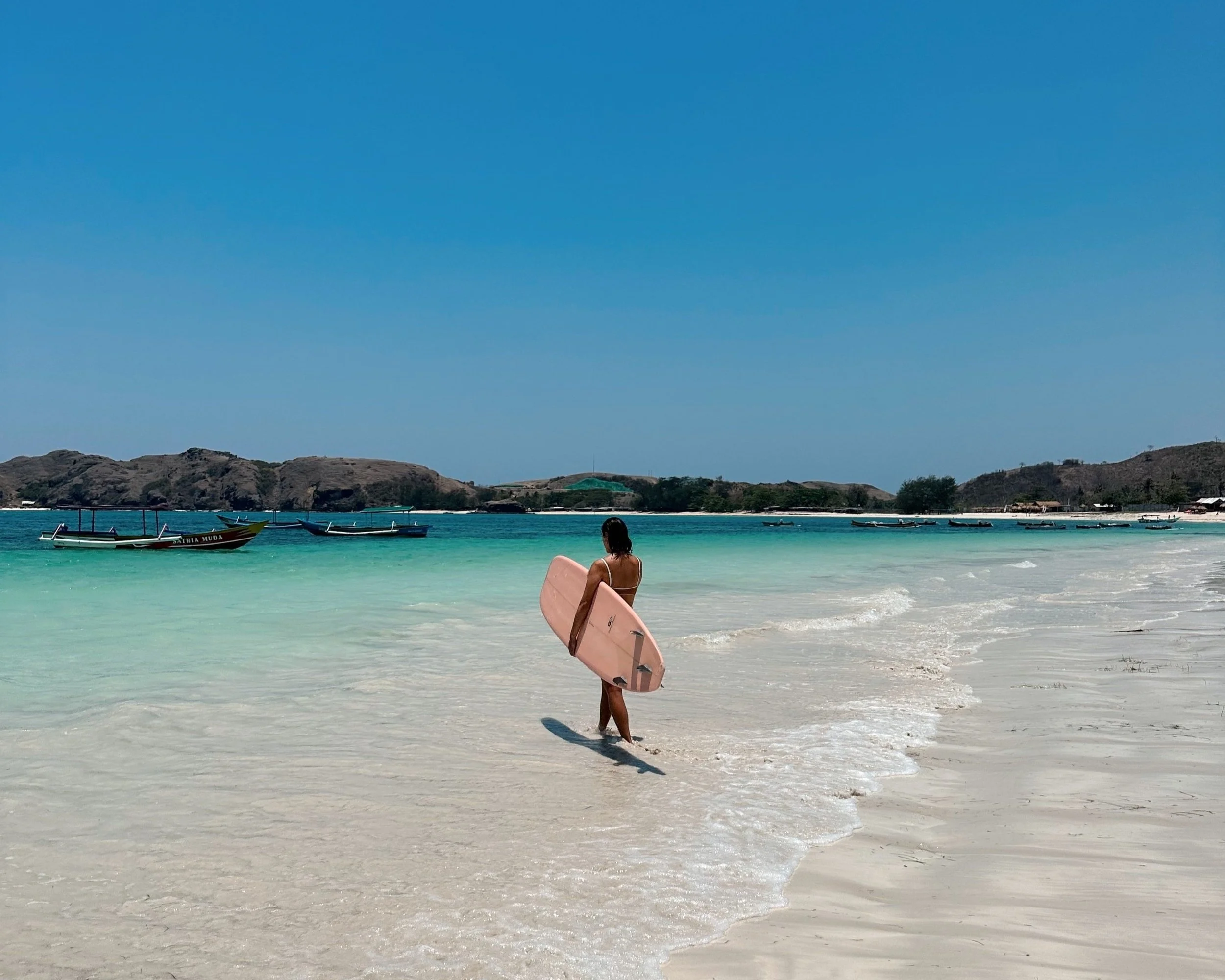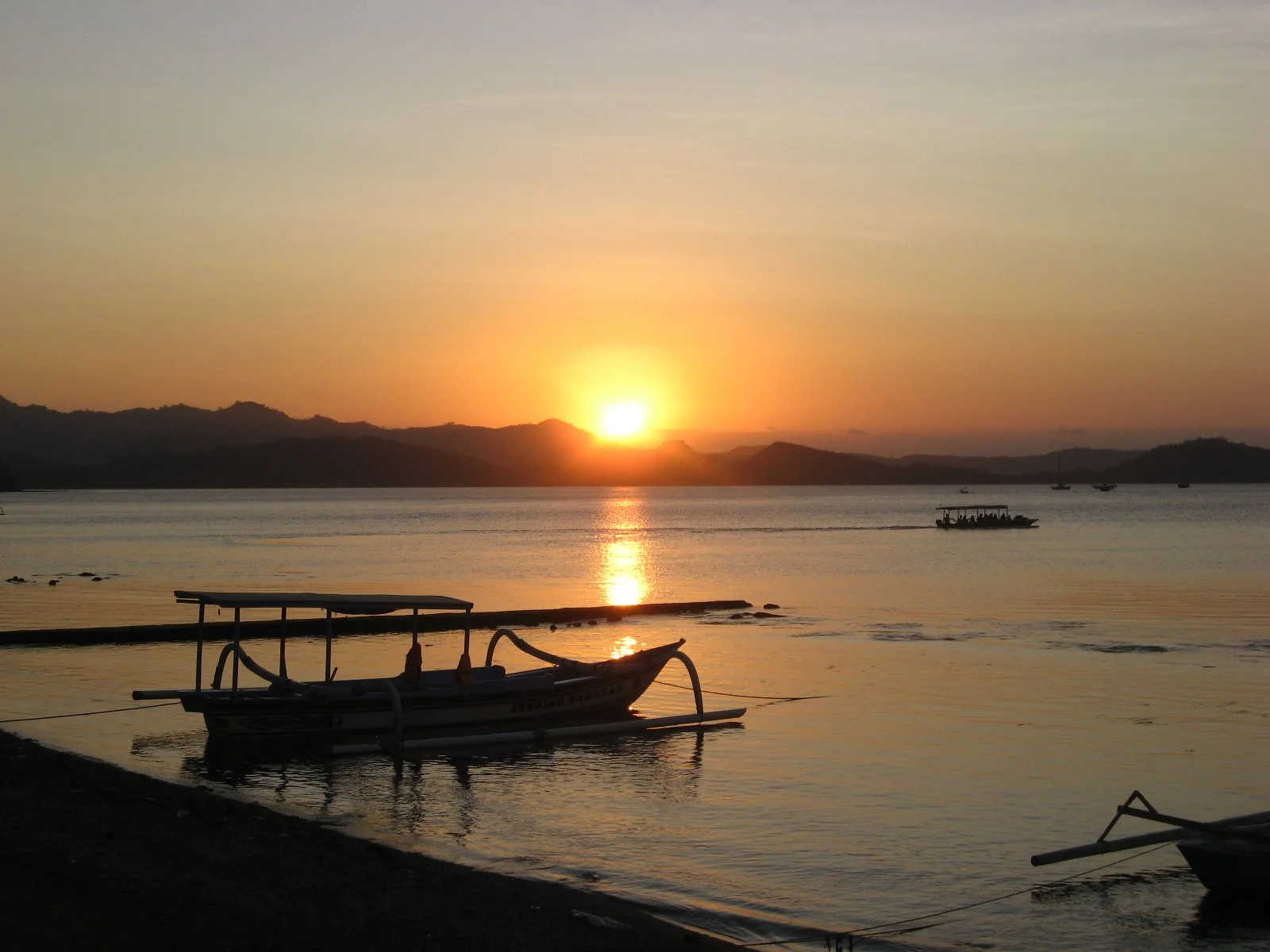THE ULTIMATE LOMBOK TRAVEL GUIDE: SURF, ISLANDS & HIDDEN GEMSGUIDE
THE ULTIMATE LOMBOK TRAVEL GUIDE: SURF, ISLANDS & HIDDEN GEMS
Described as Bali 20 years ago, Lombok feels like peeling back the layers of a paradise, one that hasn’t yet been rushed by time. Where rugged landscapes meet soulful simplicity, its essence remains raw and untamed. A sweet blend of wild nature and living tradition, Lombok invites you to slow down and move to the rhythm of the island.
THE PEOPLE OF LOMBOK
Lombok reveals another side of Indonesia, one where religion, culture and tradition run deep. From the sacred slopes of Mount Rinjani to the rural artistry villages, it’s home to the Sasak people — custodians of a culture rich in farming, craftsmanship, and intricate hand-loomed textiles.
The main religion is Islam, where roots are ever-present in the architecture. The call to prayer drifts from mosques that rise against backdrops of rice fields and rugged hills, giving Lombok its title as the island of a thousand mosques. These beautiful structures sit beside remnants of Hindu temples, whispers of Dutch colonialism and traces of Chinese and Arabic influence, where faith, artistry and nature exist in quiet harmony.
WHAT FIRST BROUGHT ME TO LOMBOK
In 2023, I spent a month moving through the familiar loop of Bali’s hotspots — dancing my way through Canggu, chasing sunsets in Uluwatu and finding stillness in Ubud’s ricefields. With no set plans or real sense of direction, I was craving a new experience where I could experience more of Indonesia, beyond the comfort of what I already knew.
A friend messaged me about her week at a surf camp in Kuta, Lombok, and it sounded like the perfect reset. With no set plans and a freshly extended visa, I booked a one-way flight and left Bali the next day.
KUTA: WHERE BALI MEETS THE DUST
Kuta is the heart of Lombok’s surf culture, where a tropical paradise meets a hint of desert wildness. Dusty roads are lined with palm trees that lead to white-sand beaches and turquoise breaks.
What I love about surf towns is the energy they carry — the stoke that radiates from surfers, the sound of soulful playlists that drift from curated cafes and boutique stores that support local design and brands. I arrived in Kuta as an absolute beginner, spending a week at LMBK Surf House, and left with a new obsession for the ocean and a different perspective on living. Surfing has become the thread that connects me to new places and people, as I’ve now chased the surf from Siargao to Sri Lanka.
A SURFER’S PARADISE
Most of Lombok’s waves are reef breaks, some only accessible by boat — my favourite kind! Out in the middle of turquoise waters with a backdrop of dusty red hills, a feeling so surreal, it feels like surfing on another planet.
Onshore, beaches are lined with umbrellas and the scent of nasi goreng drifts from beachside warungs. Local women wander the sand selling fruit and sarongs, while kids with sharp wit, hustle homemade bracelets. Out in the lineup, you will find every kind of surfer, from elegant longboarders to sun-kissed shortboarders and a whole lot of beginners discovering a newfound love for surfing.
SURF SPOTS
Desert Point – for experienced surfers, its one of the longest left-hand barrels
Ekas Inside – long, rolling waves ideal for progression
Gerupuk – multiple breaks for every level
Mawi - for experienced surfers carving barrels
Seger Beach – both left and right-hand breaks
Selong Belanak - buffalo walk across the sand while beginner catch their first waves
Tanjung Aan – dreamy turquoise water with an easy paddle-out
Best Time: Wet season (Nov–Apr) brings mellow waves for beginners. Dry season (May–Oct) brings stronger swells for advanced surfers.
THE GILI ISLANDS
Off Lombok’s northwest coast are the Gili Islands: Gili Trawangan, Gili Air, and Gili Meno. These three islands feel like stepping back in time, where there are no cars and no scooters. You’ll find horse-drawn carts known as Cidomos that jingle down dirt-paved roads and bicycles cruising along the promenade.
Each island carries its own charm, from snorkelling with turtles to beach days soaking in the sun and nights dancing under the stars. Here, you'll find island magic at its finest, where days are marked by the tides of the ocean and how salty your skin feels.
NORTHERN LOMBOK: SACRED TRAILS AND JUNGLE VALLEYS
The north is home to Mount Rinjani, Indonesia’s second-highest volcano. Hiking through dense jungles and sunburnt plains to reach its 3,726m summit was one of the most challenging and rewarding experiences. Watching the sunrise from the top, with the island unfolding beneath a blanket of clouds, made every step worth it.
The mountain villages of Senaru and Sembalun serve as gateways to climb Rinjani, offering a cooler climate, layered rice terraces, and waterfalls like Tiu Kelep and Sendang Gile. The north feels raw, grounding and deeply spiritual, where mornings are layered with mist, carrying a stillness that makes this part of Lombok feel sacred in its untouched beauty.
WEST LOMBOK AND THE SECRET GILIS
On the west coast lies Sekotong, a stretch of coastline that feels untouched by time. The port of Tambowong Harbour is the gateway to the Secret Gilis, offering a glimpse of island life where fishing and pearl farming still shape the daily life of locals.
Gili Asahan, Gili Gede, and Gili Nanggu remain authentic with a handful of boutique eco-resorts and homestays. Days here move gently, met by snorkelling vibrant reefs and paddleboarding across calm bays. It’s a place where simplicity reigns, offering travellers a slower, more grounding escape.
THE EAST: THE QUIETER COASTLINE
Lombok’s east remains quiet and untouched. Divers can explore coral gardens, while small ports lead to lesser-known Gilis like Gili Kondo, Gili Bidara, and Gili Petagan.
AND IN BETWEEN?
Between the coasts, time feels unchanged from decades ago. Terraced rice fields stretch in shades of green, kids run barefoot, and elders weave songket by hand. The Sade Village offers a glimpse into traditional Sasak life — houses are made of bamboo with thatch roofs, and handwoven textiles that carry stories passed down through generations.
Deeper inland, waterfalls like Benang Leambu and Benang Stokel take you through the rainforest, revealing the hidden beauty of central Lombok.
FINAL THOUGHTS ON WHY LOMBOK STOLE MY HEART
From learning to surf and summiting Rinjani to daily conversations with locals who taught me new Sasak words and shared their stories, the island pushed my limits and quietly changed me in ways I never expected. Its raw, soulful, and untamed essence invited me to slow down and to move with intention. A reminder that travel doesn’t always need a plan and that the magic lies in the unexpected.
-
Flight
From Bali (Denpasar) - 45 minutes direct
Cost: 1,250,000 IDR
Fast Ferry
Padang Bai to Bangsal - 2 hours
Cost: 285,000 IDR
Sanur Bai to Bangsal - 3-4 hours
Cost: 250,000-350,000 IDR
Public Ferry
Padang Bai to Lembar Harbour - 4-6 hours
Cost: 75,000 IDR per passenger + fee for vehicle
* Best option if you're travelling with a scooter/car or surfboard, or if you’re not in a rush for time
-
The best time to visit Lombok is June to September which offers the ideal balance of clear skies, great surf, and warm ocean days.
Dry season (May to Oct)
days are sunny, seas are calm, and conditions are perfect for surfing, hiking, and island hopping.
Wet season (Nov to Apr)
occasional tropical downpours but also fewer crowds and lush, green landscapes.
















